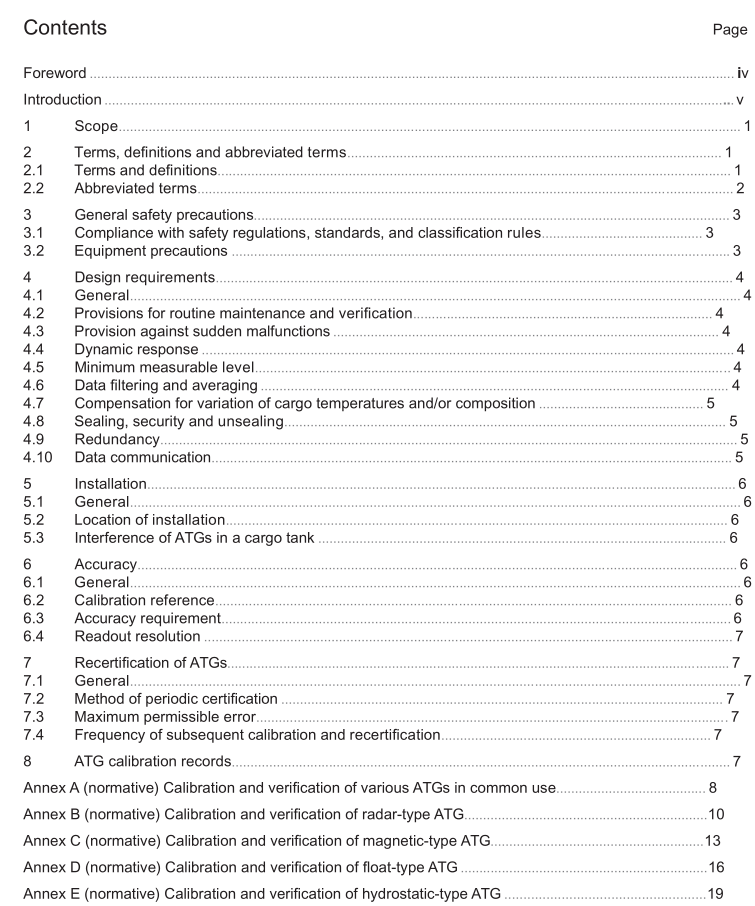BS ISO 18132-3 pdf download

BS ISO 18132-3 pdf download Refrigerated hydrocarbon and non-petroleum based liquefied gaseous fuels — General requirements for automatic tank gauges Part 3: Automatic tank gauges for liquefied petroleum and chemical gases on board marine carriers and floating storage
4 Design requirements
4.1 General The following design requirements apply to all types of ATGs on LPG carriers, FPSOs and FSOs. These requirements, which may be in addition to the technical specifications by the ATG manufacturer, should be met where they are applicable. ATGs, except that of float-type, are normally connected to a computer system designed for processing their output signal, and displaying the level, as well as temperature and other parameters, thus forming a part of an ATG system. Complete design requirements for the ATG system are not specified in this part of ISO 18132.
4.2 Provisions for routine maintenance and verification All ATGs shall be capable of withstanding vapour from cargo tanks, and allow routine maintenance to be performed without compromising the integrity of the tank. This includes means of verification whereby the ATG accuracy can be checked at high and low tank levels with the tank in service. ATG shall be equipped with a provision which enables verification of proper functioning of the ATGs at the time of each custody transfer.
4.3 Provision against sudden malfunctions ATGs shall be designed to minimize the frequency and severity of any malfunction and shall be provided with self-diagnostic features. Electronics essential for the proper functioning of the system should ideally be accessible from the deck and be serviceable with tanks in operation.
4.4 Dynamic response ATGs shall have sufficient dynamic response to track the liquid level during maximum tank filling or emptying rates. Float-type ATGs are often installed in a pipe to protect them from surge of liquefied gas in a cargo tank. To ensure equalization of the tank level and that in the pipe, the bottom and top of the pipe shall be open and equipped with sufficient perforations throughout the length.
4.5 Minimum measurable level Because liquefied gas carriers often retain a tank heel after a discharge, the ATG shall be able to measure levels as near to the bottom of the tank as possible.
4.6 Data filtering and averaging The ATG system shall be designed to automatically scan, average/filter and display the level in each cargo tank. A common practice is to use five consecutive readings to compute an averaged liquid level used to consult tank capacity tables for liquid volumes. Internal filtering algorithms shall be provided in ATG systems to reduce the impact of interferences and also applied to readouts to enable level readings to be averaged over a set number of readings or a defined period of time. Such filters may result in a significant delay, potentially of several minutes, before a reading may be observed. Filtering and automatic averaging features are recommended because a stable reading may not be available due to the vessel motion and the boiling effect of the cargo. If an automatic averaging feature is not available, multiple consecutive ATG readings corresponding to the high and low level of the wave of the cargo liquid surface shall be taken and the reading averaged for reporting.
4.7 Compensation for variation of cargo temperatures and/or composition To ensure accurate measuring results, the liquid level obtained by an ATG shall be compensated for any effect of changes in temperature, pressure or cargo properties of the respective cargo components. The compensation is either carried out by the electronics in the ATG system or manually. In particular, the ATG system shall be designed to compensate for measuring errors caused by thermal contraction/expansion of material used in the ATGs within the measurement function or by other equivalent means, and/or their installation, such as still pipe, supporting wave guides, float tapes or wires. Correction shall also be made for the thermal effects of the tank design/material. The measurement of pressure and temperature of the vapour in the tank, liquid temperature, or any other relevant parameter should be time correlated with the tank level measurement. The tank liquid temperature should be representative of the liquid contents.









